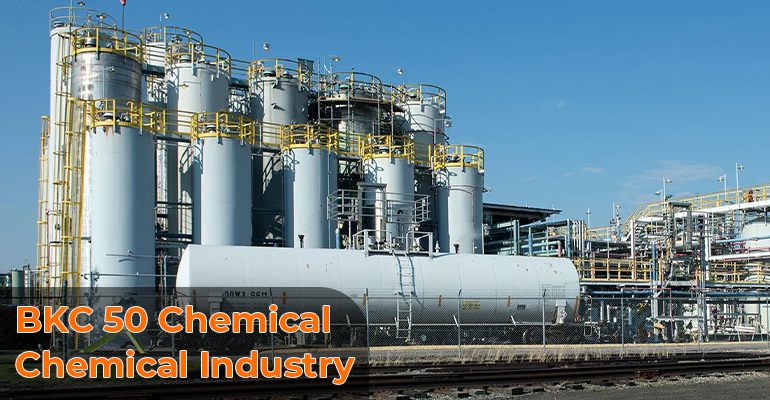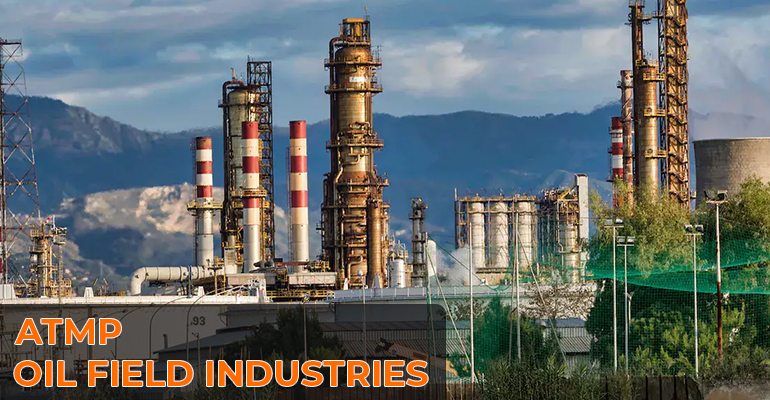ATMP is a versatile water treatment chemical widely used across industries for scale control,…
Diethylene Triamine Penta (Methylene Phosphonic Acid) for Stabilizing Pigments in Paint Formulations

Diethylene Triamine Penta (Methylene Phosphonic Acid) or DTPMPA Chemical is a nitrogenous organic polyphosphonic acid. It is a powerful chelating agent due to its unique structure, which includes five phosphonic acid groups attached to a diethylene triamine backbone.
Maxwell Additives is the Market Leader Supplier and Manufacturer of Best Quality DTPMP Chemical. This DTPMPA is used in paint formulations to stabilize pigments, particularly in aqueous-based paints. It helps in dispersing pigments evenly in the paint mixture, preventing aggregation or settling.
Understanding the Manufacturing Process of DTPMP
The manufacturing process of DTPMP (Diethylene Triamine Penta Methylene Phosphonic Acid) involves a carefully controlled chemical reaction to ensure high purity and performance. Commonly referred to as DTPMPA or DTPMPA Chemical, it is synthesized through the condensation of diethylene triamine with formaldehyde and phosphorous acid under specific temperature and pH conditions. This process requires precision, as the balance between raw materials and reaction time directly impacts the quality of the final product.
Once the reaction is complete, the solution is neutralized and filtered to remove impurities, resulting in a clear, amber-colored liquid. The final product, DTPMPA, is widely used in industrial water treatment, especially for scale and corrosion control in cooling systems, boilers, and reverse osmosis systems.
What makes the DTPMP manufacturing process unique is its emphasis on environmental compliance and consistent chemical stability. Leading manufacturers ensure strict quality control at every stage—from raw material sourcing to final packaging. This ensures that customers receive a reliable and high-performance DTPMPA chemical for various applications. As demand for sustainable water treatment solutions grows, the role of DTPMP in industrial chemistry continues to expand across global markets.
DTPMP as a Stabilizing Agent for Pigments in Paint Industry
In the paint and coatings industry, achieving long-term color stability and preventing pigment settling is crucial. One powerful additive that plays a key role in this process is DTPMP, also known as Diethylene Triamine Penta Methylene Phosphonic Acid. Commonly referred to as DTPMPA or DTPMPA Chemical, this compound acts as an effective stabilizing agent for pigments used in paints and emulsions.
DTPMPA works by dispersing and suspending pigment particles evenly, preventing them from clumping or settling over time. Its chelating properties also help reduce the interference of metal ions, which can otherwise cause discoloration or degradation in the paint formulation. This results in improved shelf life, better consistency, and enhanced color retention.
Paint manufacturers prefer DTPMPA Chemical not only for its technical performance but also for its compatibility with a wide range of formulations, including water-based systems. It ensures that pigments remain evenly distributed during storage and application, delivering a smooth and stable finish every time.
Discover the More Applications of DTPMPA
Oil Field
DTPMPA Chemical is widely used in oilfield applications, especially in scale and corrosion control. In drilling and production operations, it helps prevent the buildup of mineral scales such as calcium carbonate and barium sulfate, which can clog pipelines and reduce efficiency. Its strong chelating properties allow it to bind with metal ions, keeping them in solution and preventing deposits. DTPMP ensures longer equipment life, smoother operations, and reduced maintenance costs in harsh oilfield environments.
Textile
DTPMPA plays an important role in the textile industry as a sequestrant and stabilizing agent. During the dyeing and finishing processes, Diethylene Triamine Penta Methylene Phosphonic Acid helps control the effects of metal ions that may interfere with color vibrancy and fabric quality. It ensures uniform dye uptake, prevents discoloration, and enhances fabric softness. Its compatibility with textile auxiliaries makes DTPMPA Chemical a valuable ingredient for achieving consistent and high-quality results in textile processing.
Water Treatment Formulations
DTPMP is a key component in water treatment formulations due to its excellent scale inhibition and corrosion prevention capabilities. Used in cooling towers, boilers, and industrial water systems, DTPMPA works by binding to calcium, magnesium, and other metal ions, keeping them dissolved and preventing scale deposits. DTPMPA Chemical also provides long-term protection against rust and corrosion, making it ideal for maintaining the efficiency and longevity of water systems across various industries.
Top Reasons to Use DTPMP in Industrial Processes
Outstanding Scale Inhibition
DTPMPA Chemical is highly valued in industries for its superior scale inhibition properties. It effectively prevents the formation of calcium, magnesium, and barium scales in water systems, which can lead to blockages and reduced efficiency. This makes DTPMPA essential for processes involving heat exchangers, boilers, and cooling towers. By controlling scale deposits, it helps industries maintain consistent operation, reduce downtime, and extend the lifespan of their critical equipment.
Excellent Corrosion Control
DTPMPA acts as a reliable corrosion inhibitor in industrial environments. Its strong chelating ability binds metal ions, creating a protective layer on surfaces and preventing oxidation. This feature is especially important in systems exposed to water, chemicals, or fluctuating pH levels. Diethylene Triamine Penta Methylene Phosphonic Acid not only enhances equipment durability but also minimizes the risk of costly repairs and system failure, making it a smart choice for long-term maintenance strategies.
High Chemical Stability
DTPMP offers remarkable chemical stability under a wide range of temperatures and pH levels. This makes it suitable for harsh industrial conditions where other chemicals may break down or lose effectiveness. Whether in high-pressure steam systems or acidic environments, DTPMPA Chemical retains its performance, ensuring reliability throughout the process. This stability contributes to product consistency and operational efficiency in multiple sectors including water treatment and chemical processing.
Environmentally Friendly
Diethylene Triamine Penta Methylene Phosphonic Acid is considered a more environmentally friendly option compared to traditional phosphates. It degrades slowly and has low toxicity, making it safer for use in applications where discharge into the environment is a concern. Industries are increasingly turning to DTPMPA as part of their sustainable practices. Its eco-conscious profile helps meet regulatory standards while supporting long-term environmental responsibility without compromising on performance.
Why Does Industry Trust Us as DTPMP Manufacturer?
At Maxwell Additives Pvt. Ltd., we’ve earned the trust of industries worldwide by consistently delivering high-quality DTPMP Chemical solutions with precision, care, and reliability. As a leading DTPMP Manufacturer, our reputation is built on deep technical expertise, strict quality control, and a commitment to meeting diverse industrial needs.
Our production process for Diethylene Triamine Penta (Methylene Phosphonic Acid) is designed to ensure purity, consistency, and performance in every batch. From sourcing top-grade raw materials to advanced manufacturing practices, we uphold international standards to provide chemical solutions that meet your exact requirements.
Being a trusted DTPMPA Manufacturer, we focus not just on product quality, but also on customer satisfaction. Our dedicated support team works closely with clients to offer timely deliveries, technical guidance, and custom packaging options.
As a reliable DTPMP Supplier, we serve key industries such as water treatment, oilfield services, textiles, and detergents. Our ability to provide scalable quantities without compromising on quality is what sets us apart in the market.
When industries look for a dependable DTPMP Manufacturer, they choose Maxwell Additives Pvt. Ltd. – where quality, consistency, and customer-first service come standard.
Conclusion
Diethylene Triamine Penta (Methylene Phosphonic Acid), also known as Diethylene Triamine Penta (Methylene Phosphonic Acid), is a versatile chemical that plays a crucial role across industries—from water treatment and oilfields to textiles and paints. Its ability to inhibit scale, resist corrosion, and stabilize formulations makes it a preferred choice for high-performance and environmentally responsible solutions. At Maxwell Additives Pvt. Ltd., we are proud to be recognized as a leading DTPMP Manufacturer and Supplier, trusted by industries for our quality, consistency, and customer-first approach. Whether you’re seeking reliable supply or technical expertise, we’re here to support your industrial chemical needs.
FAQs
Q1. What is DTPMPA Chemical used for?
DTPMPA Chemical is primarily used for scale and corrosion control in water treatment systems. It’s also applied in oilfields, textile processing, and as a stabilizer in paint formulations.
Q2. Is DTPMP environmentally safe?
Yes, DTPMP has a low toxicity profile and degrades slowly, making it safer and more environmentally friendly compared to traditional phosphates, especially in wastewater discharge scenarios.
Q3. Why choose Maxwell Additives as a DTPMP Manufacturer?
Maxwell Additives Pvt. Ltd. offers high-quality DTPMP with strict quality control, custom packaging, and reliable customer service, making us a trusted manufacturer across multiple industries.
Q4. How is DTPMPA produced?
DTPMPA is produced through a condensation reaction of diethylene triamine, formaldehyde, and phosphorous acid under controlled temperature and pH to ensure high chemical stability and purity.
Q5. Can DTPMP be used in both acidic and alkaline conditions?
Yes, DTPMP is chemically stable across a wide range of pH levels, which makes it suitable for use in various industrial processes involving both acidic and alkaline environments.



